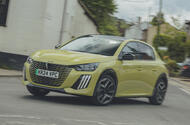This post was originally published on Autocar
Peugeot’s small electric hatchback leaves a big impression on our news editor
French carmakers have always done things a little differently. At various times they have tried – somewhat successfully to change the perception that a car needed to be a box on wheels.
Remember the shark-like Citroen DS, a car that made half-covered wheels cool, then the bonkers-looking Ami6 and, more recently, the daft Renault Avantime MPV At other times, they have tried less successfully – to reimagine what a car should be.
There was the Renault Project 900, a car that was built back to front (yes, really); the Voisin Biscooter, which looked more like a school project than a production car; and even the propeller-driven Leyat Helica, because who doesn’t want a plane that doesn’t fly?
We can’t leave out the Renault Twizy and Citroen Ami electric two-seaters, created as alternative mobility vessels. The Ami in particular feels like it has been produced for French 14-year-olds who are fed up with cycling everywhere.
But sometimes they really do get it right, like with the super cheap Citroen 2CV, which did indeed transform the automotive industry by opening motoring to the masses. Down with the haute bourgeoisie, et tout ça.

More recently, Peugeot had a stab. It’s not as dramatic as some, nor as symbolic as others, but it’s no less transformative: the iCockpit. For those unaware, this positions the instrumentation above a smaller steering wheel to enable, as Peugeot says, better manoeuvrability and increased focus on the road.
Why is this relevant? Because it’s the second generation of the Cockpit that I find in my new Peugeot e-208 – and since it concerns the primary way you interact with your car, it’s rather important. The iCockpit has featured in all new Peugeot models since it was first launched in 2013.
I remember the original advert in 2012 and a real desire to try the new 208 with the smaller wheel. That finally happened in 2017, when I got given one: a hand-me-down from my dad, who was upgrading to a Honda Civic (FK generation).
And I really did love it. The set-up was brilliant: a small car that was already quite chuckable with a smaller wheel to make it even more chuckable. What fun. So when I received a call saying a Peugeot e-208 was heading my way, I was not so silently thrilled.
I’ve had some really great times in my old 15-plate 208 – which my brother now runs as his daily – and I am excited to see if this new generation is just as smile-inducing. The new iCockpit generation, introduced in 2016 and upgraded in 2022, is definitely a move away from the original.
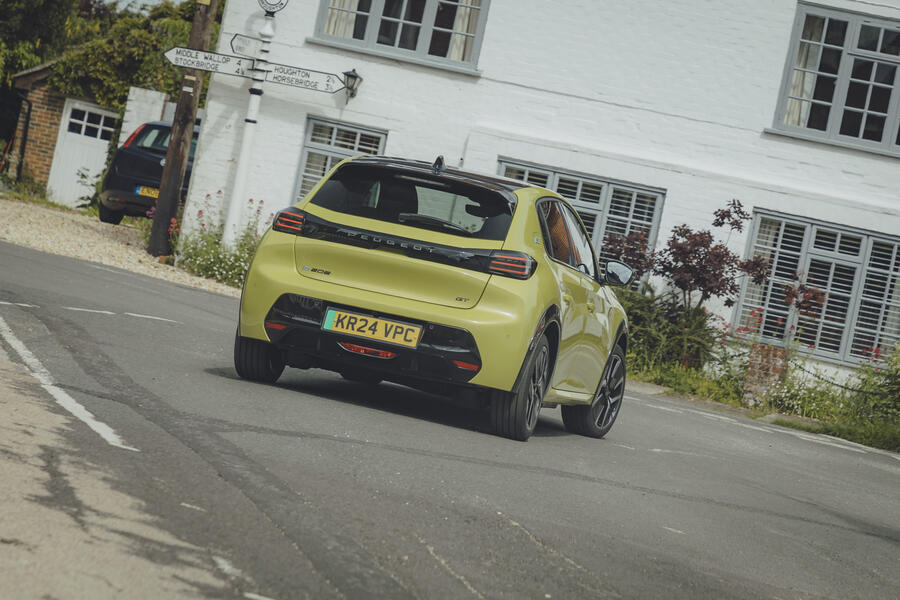
Gone are manual dials and the round steering wheel; in comes a customisable digital instrument cluster – which links up to the new i-Connect infotainment – and a wheel with a flat top and bottom.
First impressions are… mixed. It really is a slick bit of kit to use, but worries are looming over being able to adopt my preferred driving position: low seat, raised wheel. In this set-up, I’m finding the speedo is obscured by the steering wheel.
Unlike in the e-308, the screen isn’t as customisable – for example, moving the speedo so it’s higher on the screen – which is annoying. Lowering the wheel to counter this is also proving problematic because it restricts leg movement and easy pedal use. So this is an area to tweak and report back on, but I’m confident of a solution.
Anyway, beyond that, the key to a successful hatch is good looks. This has them. The updated second-generation 208 gets a more imposing face than its predecessor, with new tri-fang daytime-running lights and a broader front grille.
Our car also sports the Agueda Yellow exterior, which has proved to be a bit divisive among colleagues and friends, but I think it’s great. It would be on my spec shortlist.
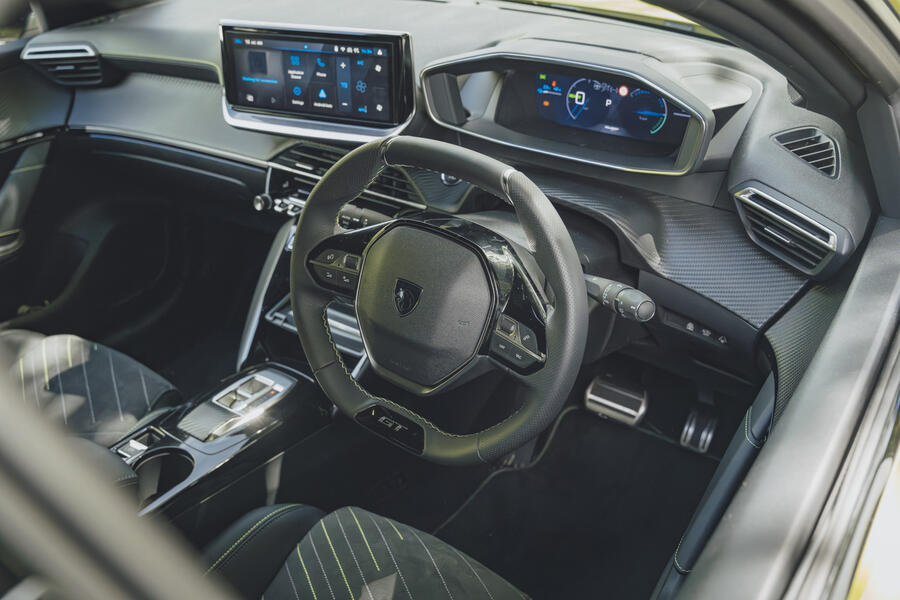
We also have GT trim, which, along with a new 10in touchscreen with wireless smartphone support and all-round sensors, adds 17in alloy wheels, a 3D instrument panel (which is quite funky) and ‘dynamic’ front seats.
Underneath, we have gone for the biggest, 54kWh (51kWh usable capacity) battery, which gives a WLTP range of around 250 miles. It can apparently be charged from 20-80% in less than 25 minutes by a 100kW charger.
Power is delivered by a new front-mounted 154bhp motor. For the eagled-eyed, this is indeed the same set-up as the new, bigger 308, the Vauxhall Corsa Electric and others in the Stellantis stable. So what are we looking to achieve during our time with the car?
First, to see why this French supermini was Europe’s best-selling car in It finished sixth last year, but with only a 6% year-on-year drop, and it currently sits fifth.
Second, to see if small hatches like this – especially with an electric powerplant – have a future. In April (the most up-to-date figures at the time of writing), it was demand for superminis – including the 208, Renault Clio and Volkswagen Golf- rather than SUVs that increased the total of new car sales across Europe by 12%.

A rather tempting £251-per-month offer – in our car’s spec – adds another pull to buyers.
Third, to find out whether the claimed range is achievable during the long-haul motorway driving I will mostly be undertaking, and if it isn’t, whether the lower mileage it offers can be lived with.
And, finally, to ascertain if the iCockpit is as good as it once was. Colleagues who have experienced it previously aren’t convinced it is and some are using that as a reason to write off the car completely. This will be a key question to answer.
So can this little electric hatchback live up to my nostalgic expectations? I hope so. During my short time with it so far, I’m already forming a bit of a connection. I’m excited to see what blossoms.
Update 2
You know what really grinds me? When manufacturers claim their new ‘small car’ is actually small. There are several examples of this, but one of the worst is the Ora 03, which is said to be a hatch when it’s actually similar in size to the Nissan Juke crossover.
Cars have become bloated partly in response to customers demanding more height and interior space, while electrification brings a big underfloor battery, which consequently makes the vehicle taller.
So how privileged I feel to be driving a genuinely small car, one that also happens to be an EV. Since taking custody of the Peugeot e-208 more than 3000 miles ago, it has become something I love coming back to and really enjoy driving.
Why? That’s a question many colleagues and friends have asked, often with a hint of sarcasm. For me, there are several reasons, but the key one is that this hatchback is actually a hatchback.
At 4055mm long, 1960mm wide (including mirrors) and 1430mm tall, it can be parked anywhere (aided by all-round sensors and that fancy ‘overhead’ camera) and traverse inner-city streets – and most importantly car parks – with an ease I’ve not experienced in most modern cars.

Seeing it not dwarf traditionally small cars, such as my neighbours’ Citroen C1 and Suzuki Swift, also brings me a little bit of joy, as does the very usable 311-litre boot.
The e-208’s short wheelbase and electric powertrain also make it immensely chuckable and it’s fun to drive in short bursts around town. You’re not overly conscious of the extra weight of the battery, and the immediate response of the 154bhp, 1991b ft motor gives the hatch a proper go-kart feel.
Even on mundane motorway trips, it still feels, to a degree, at home. I’m not normally a fan of heavily assisted cruise controls, but the Peugeot’s is easy to use and decisive in its decision making. It’s also easy to switch to the standard cruise setting.
Overall, the car is currently averaging 4.1mpkWh so, from the 48.1kWh (usable capacity) battery, I’m able to get 197 miles. My best is 4.5mpkWh, or 217 miles. Peugeot quotes 248 miles. That’s not bad going, but remember we are in the warmer part of the year.
So this small hatch is proving to be a cracking companion, with a hint of sporty flair and everyday usability. I can’t think of much more I could need.
Update 3
As an owner, you like to get reassurance that your purchase was a good choice.
So as the honorary owner of a Peugeot e-208, I crave the same thing, which means I’m regularly discussing my electric hatch to get people’s opinions and hope they affirm the car truly is good – well, apart from a few small things that I know aren’t.
As expected, the feedback has been a mixed bag. Some people are ultimately turned off by the difficult seating position afforded by the i-Cockpit (which I’ve covered in previous reports) but there is also agreement that it does indeed drive rather well.
As part of my search for affirmation, I’ve also been pondering our review of the e-208, written by road tester Illya Verpraet, which is the same spec as mine.
After 2500 miles behind its small wheel, I have come to regard the e-208 as a trusty companion, from its comfortable seats and easy-to-use infotainment to its manageable 200-mile real-world motorway range and almost-practical size.
However, reading Illya’s comments about the car’s B-road performance – “mixed bag”, “never inspires”, “snatchy” – sent shivers down my spine. There’s no way he could be talking about my beloved yellow electric hatch.
Then I realised I hadn’t really taken the e-208 for a proper back-roads jaunt. It was clearly time to prove – maybe just to myself – that those comments can’t be accurate.
Sport mode activated (this opens up 100% of the powertrain’s reserves, rather than Normal mode’s 80%), off I went for a fun hot hatch-esque weekend play.
I set up a route to Winchester, taking in as many roads as possible while avoiding the motorway.
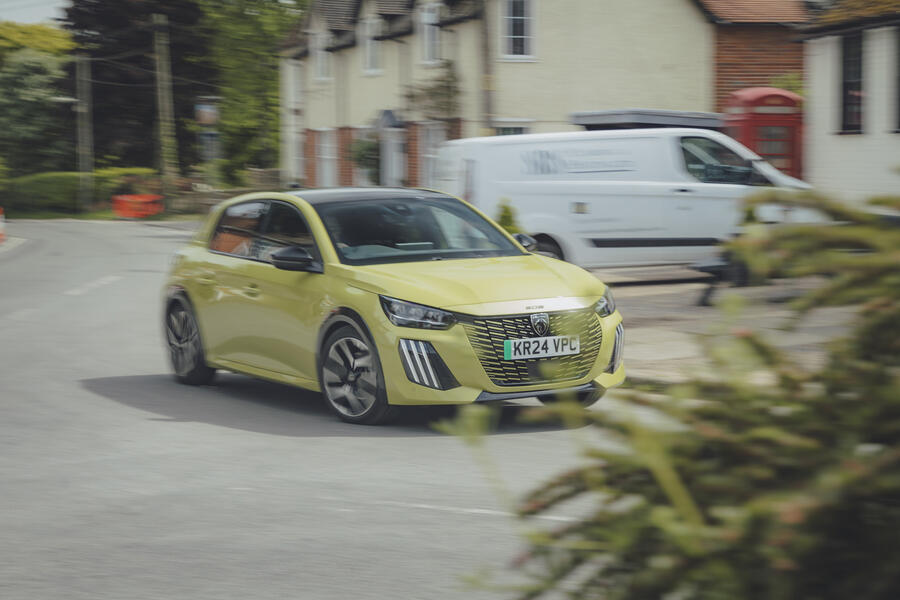
I headed off from Southampton, up the A27 through Chillworth and on towards Romsey, before turning right down a single-track lane to Ampfield. From here, it was a short stint on the long-straight A3090, before I turned onto a more demanding, winding back road.
Behind the wheel, this e-208 was a hoot, thanks mainly to the buttery-smooth electric motor and Michelin Primacy 4 tyres, as well as the rather well-tuned traction and stability controls.
Together, they provided a consistent level of both power and grip during sweeping bends, and just a touch of torque steer – but no more than that, even when floored – coming out of tighter corners. Junctions also were dispatched with minimal fuss and an absence of wheelspin off the line.
The small steering wheel too, which has received a lot of criticism from me, was the ideal size for this type of driving, giving the car a go-kart-like charm. But don’t be fooled: it was, as Illya’s test noted, lacking in both feel and precision. I’d even have to agree that “snatchy” was an accurate description.
But despite the realisation that Illya’s review was, of course, correct and I now agreed completely with what he pointed out, the smile on my face wiped away all of those annoyances.
No, the e-208 is not perfect, mainly because it’s set up as an everyday small family hatch, but it does show that there’s still fun to be had from these compact new-generation electric cars.
The lack of a loud powerplant doesn’t detract from the experience in my view and, if anything, the immediate torque on tap adds to it. What this does mean, then, is that I’ll be sure to take the back roads home more often.
Final update
On the face of it, the days of hatchbacks seem to be coming to an end. More drivers are opting for SUVs and stalwarts such as the Ford Fiesta have been binned for these taller, wider and, crucially, more profitable models.
That may seem like a dramatic statement, especially given it was the demand for superminis that inflated total new car sales across Europe by 12% last year. The year before that, Peugeot’s 208 was the continent’s best-seller.
But the switch to electric power threatens the hatchback, both because of the need for big underfloor batteries that pushes them into crossover territory and the challenge of making affordable small EVs.
So with all this small car doom and gloom, is the Peugeot e-208 (along with other Stellantis models on the same platform, such as the Vauxhall Corsa) a beacon of hope for electric hatchbacks? I would say so.
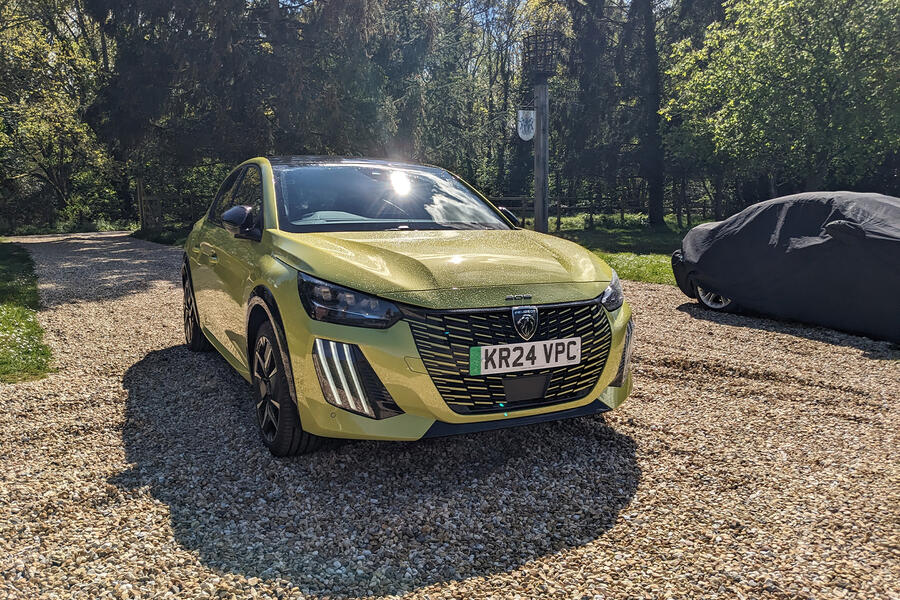
Stellantis’s e-CMP platform was designed to accommodate either a combustion engine, a hybrid powertrain or an electric motor and big battery pack. What that means, at least in theory, is you won’t really know which model you’re in until you get moving (unless you cheat and look for exhaust pipes).
This is a great advantage for our electric variant, because it actually feels like a proper hatchback, not a raised crossover like the Smart #1 or GWM Ora 03. In fact, I feel privileged to be driving a genuinely small car. And I tell you what, this thing is incredibly well suited to day-to-day life.
At 4055mm long and just 1430mm wide, it can be parked almost anywhere (further aided by all-round sensors and a fancy ‘overhead’ camera) and traverse inner-city streets and, most importantly, car parks with an ease that shames many cars today.
It doesn’t dwarf traditionally small cars, such as my neighbours’ Citroën C1 and Suzuki Swift, either, and the e-208’s 311-litre boot remains very usable.
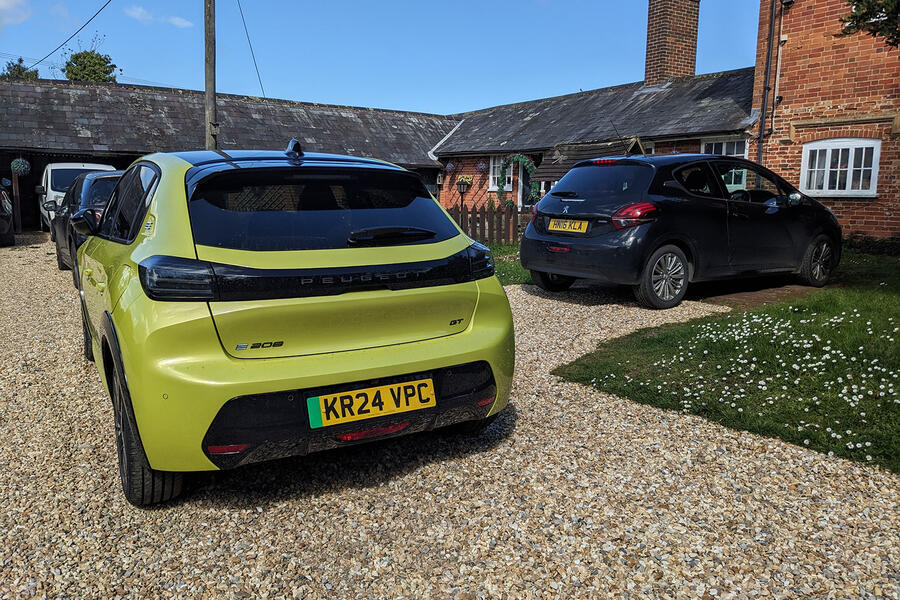
In 4000 miles with the car, I’ve used it like I would a combustion-engined alternative, with trips from my home in Southampton to Birmingham, Bristol, London and Essex.
That may not seem out of the ordinary, but what I’m getting at is I never felt any range anxiety, which is a rare thing in 2024 in an EV costing less than £40,000.
This is a result of its ability to eke out up to 4.5mpkWh, or 217 miles, from its 48.1kWh battery (Peugeot claims a top end of 248 miles). Via DC outlets, the e-208’s 100kW maximum charging speed means top-ups are a doddle, and it makes up for slower 7.4kW AC rates.
I’ve enjoyed not having to worry about those mileage stats and taken the e-208 off motorways wherever possible. A short wheelbase makes it immensely chuckable (aided by the smaller steering wheel) and the immediate torque of the 154bhp motor gives it a proper go-kart feel. You don’t really notice the extra weight of the battery.

Peugeot’s quirky interior design ethos adds to the experience, too. I love the piano key-style physical buttons, the seats hug you and are brilliantly comfy and the infotainment is easy to use on the move. And although the small wheel may be divisive, I think it’s great.
The e-208 is a fantastic thing. I’m a lover of small cars and this one really does tick all the boxes. But nothing is perfect, which brings us to the i-Cockpit. I love the small wheel, but the position of the display behind it is hugely flawed.
Normally I adjust the wheel to just clear my legs. In any other car that’s not an issue, but in the 208 the wheel blocks the speedo. So instead I have to almost rest the wheel on my thighs, which is uncomfortable.
I’ve spoken with other owners, and opinions are split. Regardless, one small gripe doesn’t define a car. Just ask my brother, who is now looking to buy an e-208 of his own, driven by his love of that small steering wheel (the i-Cockpit doesn’t really affect or bother him) and the plushness of the interior compared with more standard-feeling rivals.
What a companion it has been. I can’t think of much more I could need from a small hatch with a hint of sporty flair and everyday usability.

